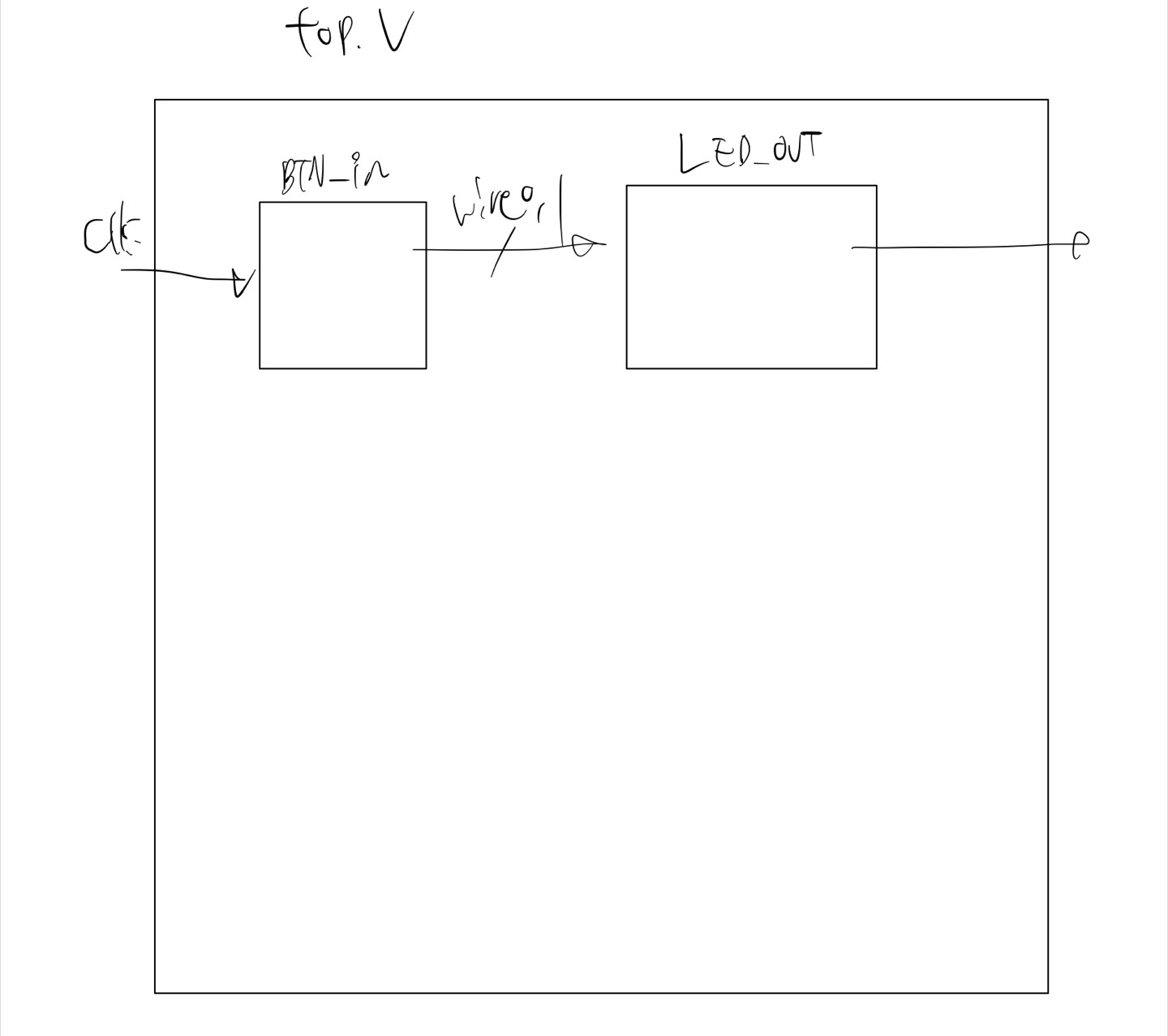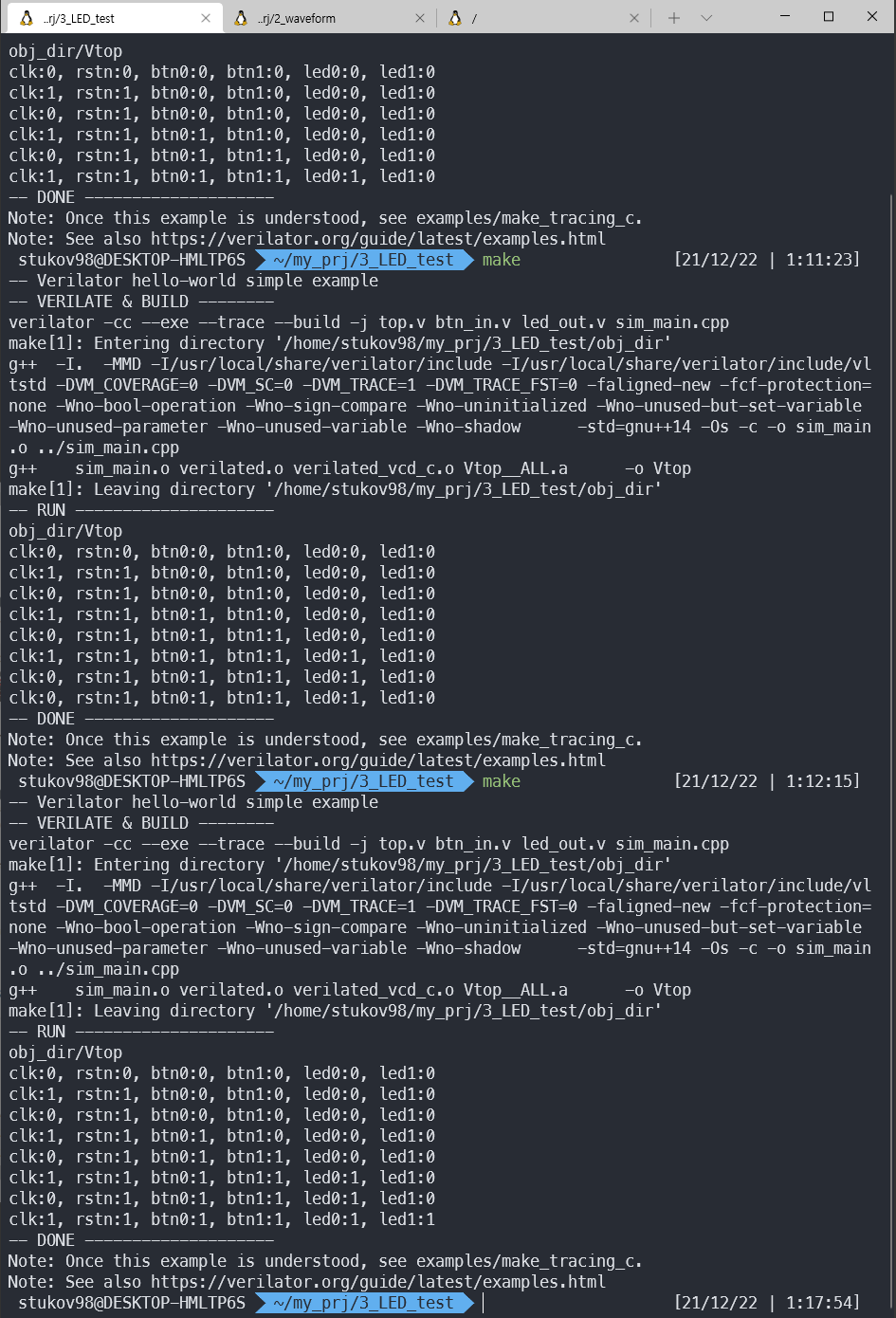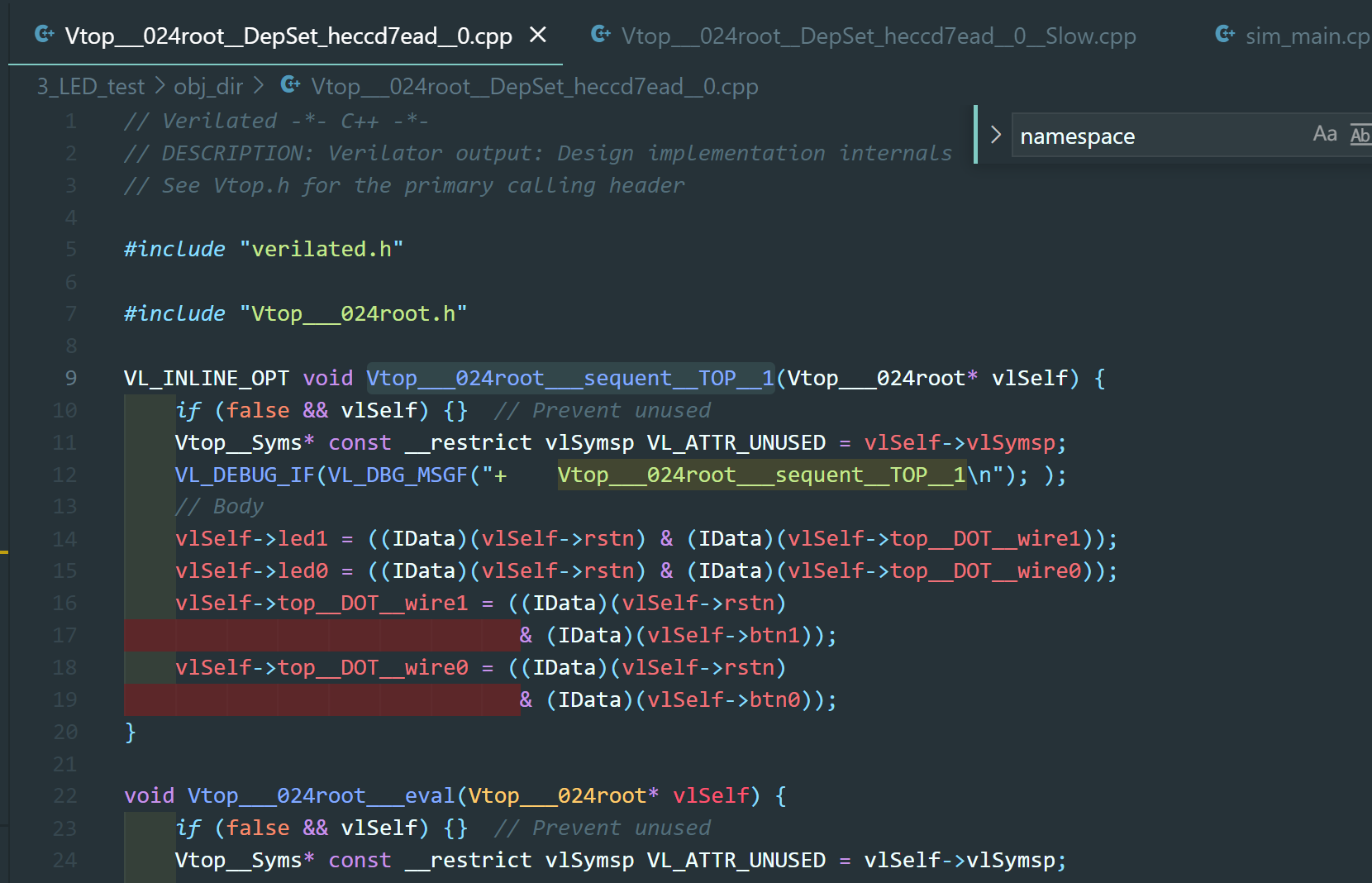이제 여러 .v 파일의 여러 module 을 합성해볼 차례이다.
이 다음부터는 Verilator 공식문서 정독포함 약 3시간의 삽질이 들었고, 그 결과 Verilator 에 대한 대략적인 감이 잡히게 되었다.
그 삽질의 결과를 여기에 기록하고자 한다.
여러 Verilog 파일을 합성하고자 하면 어떻게 해야 하는가?
이 경우엔 단도직입적으로 결과를 설명함과 함께 코드의 의미를 설명하는게 맞다는 생각이 들었다.
우선,

매우매우매우매우 간단한 "여러 모듈로 설계된 HW 조립체" 를 top.v 로 구성한다.
top.v 로부터 받은 입력을 BTN_in과 LED_out 모듈이 받아서 다시 top.v 의 출력에 연결해주는 것이다.
그 코드는 아래와 같다.
top.v
/*
Make LED_BLINKER
*/
// `include "led_out.v"
// `include "btn_in.v"
module top
(
input clk,
input rstn,
input btn0,
input btn1,
output reg led0,
output reg led1
);
wire wire0;
wire wire1;
BTN_in blk(
.clk(clk),
.rstn(rstn),
.in0(btn0),
.in1(btn1),
.out0(wire0),
.out1(wire1)
);
LED_out led(
.clk(clk),
.rstn(rstn),
.in0(wire0),
.in1(wire1),
.out0(led0),
.out1(led1)
);
endmodulebtn_in.v
module BTN_in
(
input clk,
input rstn,
input in0,
input in1,
output reg out0,
output reg out1
);
always @(posedge clk or negedge rstn) begin
if(!rstn) begin
out0 <= 0;
out1 <= 0;
end
else begin
out0 <= in0;
out1 <= in1;
end
end
endmoduleled_out.v
module LED_out
(
input clk,
input rstn,
input in0,
input in1,
output reg out0,
output reg out1
);
always @(posedge clk or negedge rstn) begin
if(!rstn) begin
out0 <= 0;
out1 <= 0;
end
else begin
out0 <= in0;
out1 <= in1;
end
end
endmodule보다시피 `include도,
`timescale 1ns/100fs도 없다.
단도직입적으로 말하면, Makefile에 아래와 같이 적어주면 된다.
######################################################################
#
# DESCRIPTION: Verilator Example: Small Makefile
#
# This calls the object directory makefile. That allows the objects to
# be placed in the "current directory" which simplifies the Makefile.
#
# This file ONLY is placed under the Creative Commons Public Domain, for
# any use, without warranty, 2020 by Wilson Snyder.
# SPDX-License-Identifier: CC0-1.0
#
######################################################################
# Check for sanity to avoid later confusion
ifneq ($(words $(CURDIR)),1)
$(error Unsupported: GNU Make cannot build in directories containing spaces, build elsewhere: '$(CURDIR)')
endif
######################################################################
# This is intended to be a minimal example. Before copying this to start a
# real project, it is better to start with a more complete example,
# e.g. examples/make_tracing_c.
# If $VERILATOR_ROOT isn't in the environment, we assume it is part of a
# package install, and verilator is in your path. Otherwise find the
# binary relative to $VERILATOR_ROOT (such as when inside the git sources).
ifeq ($(VERILATOR_ROOT),)
VERILATOR = verilator
else
export VERILATOR_ROOT
VERILATOR = $(VERILATOR_ROOT)/bin/verilator
endif
default:
@echo "-- Verilator hello-world simple example"
@echo "-- VERILATE & BUILD --------"
$(VERILATOR) -cc --exe --trace --build -j top.v btn_in.v led_out.v sim_main.cpp
@echo "-- RUN ---------------------"
obj_dir/Vtop
@echo "-- DONE --------------------"
@echo "Note: Once this example is understood, see examples/make_tracing_c."
@echo "Note: See also https://verilator.org/guide/latest/examples.html"
######################################################################
maintainer-copy::
clean mostlyclean distclean maintainer-clean::
-rm -rf obj_dir *.log *.dmp *.vpd core
즉,
$(VERILATOR) -cc --exe --trace --build -j top.v btn_in.v led_out.v sim_main.cpp로써 포함될 .v 파일을 전부 명기해주기만 하면 된다.
그 실행결과는 아래와 같다.

튀기는 것에 따라 led1, 0 이 상승하강하는 것을 볼 수 있으며
top->eval() 이전에 발생한 top->???? 의 변수변화는 셋업타임이 만족되지 않으므로 당연히 동시에 처리되며 따라서 다다음 eval() 부터 반영됨을 확인할 수 있다.
이러한 구현이 어느 파일에 되어있는가를 확인하고자 한다면, obj_dir 에 있는 파일을 뜯어봐야 하는데

의 형태로 내부에서 알아서 BTN_out, LED_out 까지 최적화하여 구현되어있음을 확인할 수 있다.
